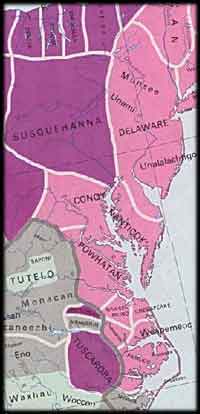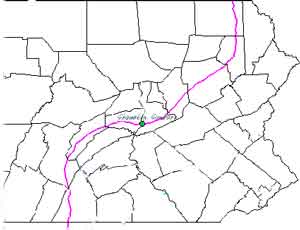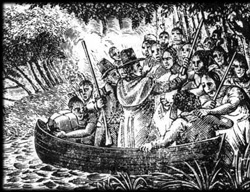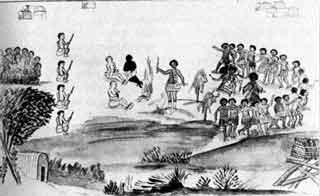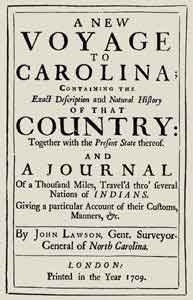In
Depth History post contact Period
More than a year before the massacre and
"evidently looking to a removal from North Carolina, and a location in
a less hostile neighborhood, the Tuscaroras in 1710 ...had sent an embassy
to the Government of Pennsylvania. At Cones-toga, June 8th, they were met
by two white commissioners, and by Conestoga and Shawanese chiefs....
The Tuscaroras further said at this time that they were under command of
the Five Nations, and were their sub-jects, 'and that wherever they should
please to tell them to go and reside, there they would make their dwelling,'
and the arrangement was confirmed with twenty large belts and twice three
strings of wampum....
About this time the New York tribes reported
to Burnet that French Indians (i. e., tribes in allegiance to tbe French
in Canada), were living with the Tuscaroras ''near Virginia and go backwards
and forwards....In 1722 the Tuscaroras, having been formally incorporated
into the league, were sharing in councils with the English at Albany. Others
of the tribe had settled with the Iroquois of Conestoga in what is now
Lancaster County, Pa.; and still others pitched their lodges with Shawanese
and Mohawk at Oquaga, now Windsor Broome County, .N York......In 1768 The
Tuscaroras had 140 fighting men-and probably more than twice as many women
and children-in one vi1Iage six miles from the principal Oneida village.
There were still several Tuscarora settlements in tile Susquehanna. Valley,
those who had stopped &t Tamaqua, Pa., in 1713 appear to have removed
after two years. These were adopted by the Senecas as children." ".33
"The Tuscaroras did not all come north
at once, but in detached fragments, covering a period of fifty-five years.
During that time there was more or less mingling together of those north
with those who located at points south. The main castle being at Milligans,
in what is now Juniata county, attracted the various sections of the tribe
to that place. It was by going backward and forward of the Tuscaroras that
the path was formed which gave to the valley the name it has ever since
borne."PATH
VALLEY BEFORE THE REVOLUTION.
"Path Valley, situated in the northwestern
part of Franklin County Pennsylvania, is parallel with the main, or Cumberland
Valley, but separated from it by the Kittatinny and Blue Mountains, two
ranges terminating near Loudin in Jordan's and Parnell's knobs. The Tuscarora
Mountain bounds it on the west. The entrance to the main valley is very
narrow. The west branch of the Conococheague, flowing south, drains Path
Valley, which gradually widens as it extends northward. At the northern
end a spur of the main ridge, called Knob Mountain, projects southward
about eight miles, dividing the valley. The eastern folk, in which flows
the main stream and which is very narrow, is called Amberson Valley, while
the wider portion, or Path Valley, is drained by a tributary called Dry
Run, which starts near Doylestown. At this place another stream has its
rise, called Tuscarora Creek, which flows northward, cuts through Tuscarora
Mountain, near Concord, follows the western side of that mountain through
Juniata county and empties into the Juniata river at Port Royal, forming
Tuscarora Valley. The two valleys are a continuous route, with a water
course gap through the mountain, running north from the Cumberland Valley
to the Juniata. The mountain limiting Path Valley on the west, the valley
in Juniata county on the east, the valley itself, and the creek flowing
through it, take their names from and will preserve for all time the memory
of the Tuscarora tribe of Indians who were the original owners of the country
of which the section forms a part.....The Tuscaroras in North Carolina
engaging with the whites in a war in March, 1713, were defeated and for
greater protection from their conquerors fled northward and joined the
Five Nations in 1715, receiving land from the Oneidas, where Wincheser
now is, some near Martinsburg, on the creek that still retains their
name, and large numbers in Tuscarora Valley, Juniata county, which is a
continuation of Path Valley, their principle castle being near Academia....The
Tuscaroras did not all come north at once, but in detached fragments, covering
a period of fifty-five years. During that time there was more or less mingling
together of those north with those who located at points south. The main
castle being at Milligans, in what is now Juniata county, attracted the
various sections of the tribe to that place. It was by going backward and
forward of the Tuscaroras that the path was formed which gave to the valley
the name it has ever since borne. Originally is was called Tuscarora Path
Valley, but subsequently the word Tuscarora was dropped, for after 1754
it is known simply as Path Valley, the continuation of the valley in Juniata
county being known as Tuscarora Valley.
The Indians seldom diverge from a straight
track. By reference to ancient or modern maps it will be seen that Path
Valley was the logical route from the south to that portion of New York
in which the Five Nations were located. In the retreat from North Carolina,
to form an alliance with the five Nations, the Tuscarora's first entered
and passed through Path Valley, some locating in Tuscarora Valley, as we
have already seen.
It would, of course, be impossible, in
the absence of any allusion to the subject in the records, to even conjecture
the number of Indians who made their home in Path Valley prior to its purchase
in 1754. There is no account of any Indian town in the valley, but that
they were there, transiently at least, in considerable force and prized
the territory highly, is apparent from the vigorous and successful efforts
they made by civil process to dislodge the early white settlers.
In 1753 there was evidently an important
meeting of the Indians held in Path Valley, from the fact that John O'Neil,
writing from Carlisle to Governor Hamilton, under date of May 27, 1753,
refers to the opportunity which presented itself to him of learning the
Indian character by at-tending a great Indian talk in Path Valley, the
particulars of which Le Tort would furnish the governor. Whether Le Tort,
who was the Indian interpreter at Carlisle, and for whom the stream running
through that town was named, ever did so or not cannot be ascertained from
any of the records.
Path Valley was a popular place for Indian
traders, more especially after the locating of the Tuscaroras in that section,
and early maps show it to have been dotted here and there with the paths
over which these traders trod on their way to the wilderness where civilization
had not as yet penetrated. These paths were numerous but the principle
one was that running from Shippensburg through Roxbury Gap, then across
Path Valley to Aughwick and on to Kittanning. Another ran by way of Fannettsburg.
" PATH
VALLEY BEFORE THE REVOLUTION. Hon. A. N. Pomeroy. April 28, 1898.compiled
from information supplied by the Coyle Free Library in Chambersburg , PA
and provided to Tuscaroras.com by Linda Carter
More than a year before the massacre and
"evidently looking to a removal from North Carolina, and a location in
a less hostile neighborhood, the Tuscaroras in 1710 ...had sent an embassy
to the Government of Pennsylvania. At Cones-toga, June 8th, they were met
by two white commissioners, and by Conestoga and Shawanese chiefs....
The Tuscaroras further said at this time that they were under command of
the Five Nations, and were their sub-jects, "and that wherever they should
please to tell them to go and reside, there they would make their dwelling,"
and the arrangement was confirmed with twenty large belts and twice three
strings of wampum".
After this the sachem Decanasora, in full
meeting not only of the sachems but of all the inhabitants," etc., assembled
at Onondaga, said:
The fugitive Tuscarora asked for a cessation
of hostilities, and made overtures for peace which have been recorded as
follows:
''By the first belt, the elder women and
the mothers besought the friendship of the Christian people, the Indians
and the Government of Pennsylvania; so they might fetch wood and water
without risk or danger. By the second, the children born and those about
to be born implored for room to sport and play without the fear of death
or slavery. By the third, the young men asked for the privilege to leave
their towns without the fear of death or slavery to hunt for meat for their
mothers, their children, and the aged ones. By the fourth, the old men,
the elders of the people asked for the consum-mation of a lasting peace,
so that the forest (the paths to other tribes) be as safe for them as their
palisaded towns. By the fifth, the entire tribe asked for a firm peace.
By the sixth, the chiefs asked for the establishment of a lasting peace
with the Government, people, and Indians of Pennsylvania, whereby they
would be relieved from those fearful apprehensions they have these several
years felt.
By the seventh, the Tuscarora begged for
a cessation from murdering and taking them,' so that thereafter they would
not fear 'a mouse, or anything that ruffles the leaves.' By the eighth,
the tribe, being strangers to the people and Government of Pennsylvania,
asked for an official path or means of communication between them." (Bureau
of American Ethnology, "Handbook of American Indians!' Part II. p.843)...
The Tuscarora belts - sign of their supplication-were
sent by the Conestogas to the head council of the Five Nations at Onondaga;
and here their story becomes a part of that of New York State...A portion
of the Oneidas' territory was assigned to them, bounded by the Susquehanna
on the south, the Unadilla on the east, the Chenango on the west. How many
made up the first band that came, seems nowhere stated. They did not all
leave North Carolina at once, nor did they all come through to New York.
In 1720 some of them were living In Virginia, and complaints reached New
York's governor Burnet of robberies committed by straggling bands of Tuscaroras
and others of the Iroquois. Two Tuscaroras came to Governor Burnet with
a war belt from the Gover-nor of Virginia (as they said), asking that the
Five Nations should declare war on the Catawbas. About this time the New
York tribes reported to Burnet that French Indians (i. e., tribes in allegiance
to tbe French in Canada), were living with the Tuscaroras ''near Virginia
and go backwards and forwards....In 1722 the Tuscaroras, having been formally
incorporated into the league, were sharing in councils with the English
at Albany. Others of the tribe had settled with the Iroquois of Conestoga
in what is now Lancaster County, Pa.; and still others pitched their lodges
with Shawanese and Mohawk at Oquaga, now Windsor Broome County, .N Y......In
1768 The Tuscaroras had 140 fighting men-and probably more than twice as
many women and children-in one vi1Iage six miles from the principal Oneida
village There were still several Tuscarora settlements in tile Susquehanna.
Valley, those who had stopped &t Tamaqua, Pa., in 1713 appear to have
removed after two years. These were adopted by the Senecas as children."
It remains to trace briefly the fortunes of some of these people who had
remained in North Carolina, where their number had been estimated-probably
over-estimated at from 3,000 to 4,000. Sir William Johnson even reported
that in six North Carolina towns they numbered 5,000 or 6,000; but subsequent
records do not account for such numbers. In 1766, 160 Tuscaroras, just
from North Carolina, came in on Sir William Johnson and were sent to New
York villages.
In 1767 there was another fragmentary migration,
many Indians of various tribes, including the Tuscarora, being attracted
to the Moravian Mission at Friedenshuetten, on the Susquehanna near Wyalusing.
The missionaries re-ported that they were lazy "and refuse to hear religion."
Some of them who had camped near the river, were so alarmed at a snowfall,
the first they had ever seen, that they begged the missionaries to give
them refuge.
Various companies of them corning into
the Colony of New York, sites were assigned them. In the northern part
of the Oneida territory, already mentioned, they were allotted to Ganasaraga
near present Sullivan, Madison County; and to Kaunehsuntahkeh exact site
uncertain. Of the migration of 1766, Sir William Johnson wrote to the Earl
of Shelburne, December 16th of that year:
This moment an interpreter arrived here
with several Tuscarora chiefs returned from North Carolina whither they
went last spring in order to
bring the remainder of their tribe out
of danger from that government, which they have now done to the number
of 160, and they have produced to me certificates of their quiet behavior
and decorum,, under the seals of the magistrates of the several districts
thro which they passed; notwithstanding which, by the account the interpreter
and they give me, as also from the letters I received by them, I find that
on their way, their lives were several times attempted by the frontier
people, who assembled for that purpose, to prevent which for the future.
one of my officers, that way, was necessitated to but the Crown to the
charge of an- attendant white man, and that on their return, having sold
part of .there lands in Carolina and purchased sundry horses, wagons etc.
for carrying some effects, they were again used ill at Paxton in Pennsylvania
and robbed of several horses, etc., valued at £55; of this the Tuscarora
chiefs complained to several of the Six Nations-, and I have just now with
difficultyprevented them from making a formal complaint to the whole Confederacy
on promising them that it should be inquired into....
The actual migration of the Tuscarora,
then, as we have shown, from North Carolina to New York State, occurred
at various times from 1712 to 1802 Now began a series of efforts to dispossess
them in New York State and remove them to various places in the West. Into
the intricate history of these attempts it is not here designed to enter.
About 1818 it was proposed to purchase lands in the neigh-borhood of Green
Bay, Wisconsin, held by the Menomonees and Winnebagoes, and transfer to
them certain New York tribes, the Tuscarora among them. The scheme came
to naught. Later, their removal to the Indian Territory was undertaken,
and in May, 1846, about 40 were induced to embark on a lake Erie steamboat
Some 200 Tuscarora, Senecas and others, finally reached the promised land
of the Indian Territory. Within a year, a third of them had died from privation
and disease. The Government, how-ever benevolent its designs, had failed
in giving propercare to its incapable wards; and the misconduct of agents
turned the attempt into a cruel and fatal fiasco, the story of which may
be traced in treaties and memorials through many years.33
Sources and Links Follow
On to the
Susquehannocks , the Mingo, the Shawnee,
and the Munsee and Delaware
Indians of Pa. to
Top of Page
Links:
Native
American Groups , a link to many very useful sites on Natives from
awesomelibrary.org
First
Nations Histories [in which are found many of Lee Sultzman's tribal
descriptions directly linked in sources above]
Native
Languages of the Americas: Algonquin (Algonkin, Anishnabe, Anishinabe,
Anishnabek) describes the language and the proper use of the term Algonquin
and Algonquian. Algonquian is the correct form for the larger language
of which Algonquin is just one.
Algonquian
Language Family (Algic) [lists and provides links to the tribes who
spoke Algonquian
John R. Swanton. (New Jersey) Extract
from The Indian Tribes of North America by John R. Swanton.
Bureau of American Ethnology Bulletin 145ó1953. [726 pagesóSmithsonian
Institution] (pp. 48-55). Presented in pages of
the
Northern Plains Archive Project web site.
Our
Tuscarora Neighbors [a history in 6 parts ] by Frank H. Severance
|
Sources
for This Page:
1. State Museum of Pennsylvania.
Brief
Summary of the 1681 Charter.
2. From York
County History Pages of York
County Webpages.
3. Penn
and the Indians
page of site entitled " William Penn. Visionary Proprietor" by
Tuomi J. Forrest
4 Indians,
Sources, Critics by Will J. Alpern (Prudential-Bache Securities). Presented
at the 5th Cooper Seminar, James Fenimore Cooper: His Country and His Art
at the State University of New York College at Oneonta, July, 1984. ©1985
by State University of New York College at Oneonta ["may be downloaded
and reproduced for personal or instructional use, or by libraries" ] Originally
published in James Fenimore Cooper: His Country and His Art, Papers from
the 1984 Conference at State University of New York College -- Oneonta
and Cooperstown. George A. Test, editor. (pp. 25-33)
5. Kittanning-pa.com
6. SUSQUEHANNOCK
HISTORYpart of First
Nations, Issues of Conesquence pages. Lee Sultzman
7. SUSQUEHANNOCK
HISTORY, Lee Sultzman. Part
of First
Nations Histories
8.Information
on the Susquehannock Indians from Pagewise
9. Delaware
History by Lee Sultzman.. Part of First
Nations Histories
10. Where
are the Susquehannock now? part of the pages of BrokenClaw.com
12.
Native
Americans Post Contact:, from The
Mariners Museum, Newport News, Va pages
13. . Internet
School Library Media Center, Monacan
Indians page.
14. AN
AMERICAN SYNTHESIS The Sons of St. Tammany or Columbian Order . [ the
footnotes evident in the text takent from "an American Synthesis" can be
accessed at the link given in source
15. Iroquois
.
By: Joe Wagner, with references provided.
16. The
Iroquois. by Lee Sultzman. Part of First
Nations Histories
17 William
Henry Harrison and the West , part of Dr James B. Calvert's pages
at University of Denver Website.
At the time of Penn's arrival in 1682,
the Susquehannock were subservient to the Iroquois Confederacy, just as
their enemies and neighbors, the Delaware , were. The Susquehannock were
decimated by war and disease, but the Lenape remained vital.
18. Shawnee's
Reservation a detailed site on Shawnee History
19. Shawnee
History by Lee Sultzman. . Part of First
Nations Histories
20. Marjorie Hudson,
Among
the Tuscarora: The Strange and Mysterious Death of John Lawson, Gentleman,
Explorer, and Writer, North Carolina Literary Review, 1992 [transcribed
at East North Carolina Digital History Exhibits]
21. Chief
Logan: Friend, Foe or Fiction? by Ronald R. Wenning. The
Journal of the Lycoming County Historical Society, Volume XXXVII, Number
1, Fall, 1997
22. Mingo
Indians part of The Allegheny Regional Family History Society's Web
pages
23. Weiser,
Shikellamy and the Walking Purchase By Al Zagofsky
24. Conrad
Weiser from the Pennsylvania Historical and Museum Commission
25. The
Walking Purchase from Pennsylvania Historical and Museum
Commission
26. James
Logan , Mingo Indian from The American National Biography, published
by Oxford University Press under the auspices
of the American Council of Learned
Societies.
27. The
Lineage of Mother Bedford from Mother
Bedford , a website devoted primarily to the history of Old-Bedford
County, Pennsylvania during the American Revolutionary War period.
28. Year
1736. part of the webpage entitled "Ben Franklin :A Documentary
History" by J A Leo Lemay , English Department , Professor University
of Delaware, Newark, Delaware.
29. Shawnee'
entry from Hodge's Handbook Abstract: The 'Shawnee' entry from Handbook
of American Indians North of Mexico, edited by Frederick Webb Hodge (Smithsonian
Institution, Bureau of American Ethnology Bulletin 30. GPO: 1910.)
30. John
Lawson 1714, from The American Philosophical Society Library and Webpage
31 . The
Iroquois as found in the Catholic Encylopedia's Indepth Study involving
social, cultural , political and religious history
32. Cherokee
History by Lee Sultzman. Part of First
Nations Histories
33. Our Tuscarora Neighbors by Frank H Severance [ca
1915] part
Two
All Pages of WIthin the Vines are Copyright Protected. See Terms
of Use.
|
